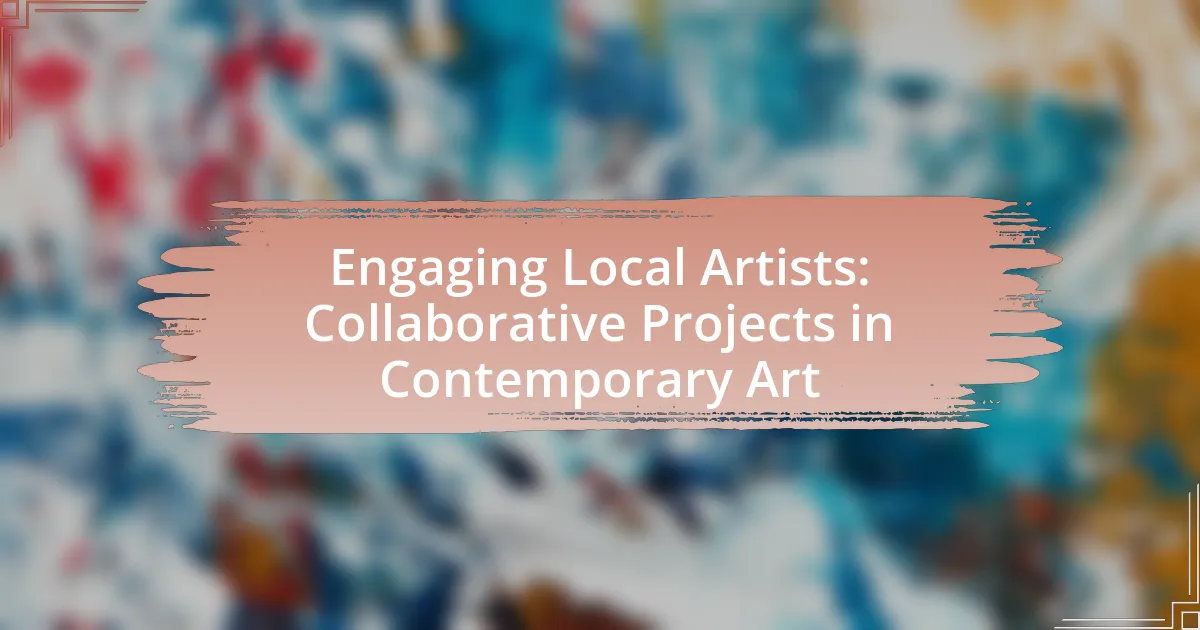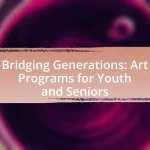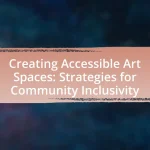Collaborative projects in contemporary art involve multiple artists, communities, or organizations working together to create shared artistic outcomes, emphasizing collective creativity and participation. These initiatives engage local artists by providing opportunities for collaboration, exposure, and financial support, enhancing their visibility and fostering community ties. The article explores the roles of local artists in these projects, the benefits they receive, and the importance of collaboration in addressing social issues and promoting cultural exchange. It also discusses the challenges faced by local artists, strategies for effective collaboration, and successful examples of community engagement through art.
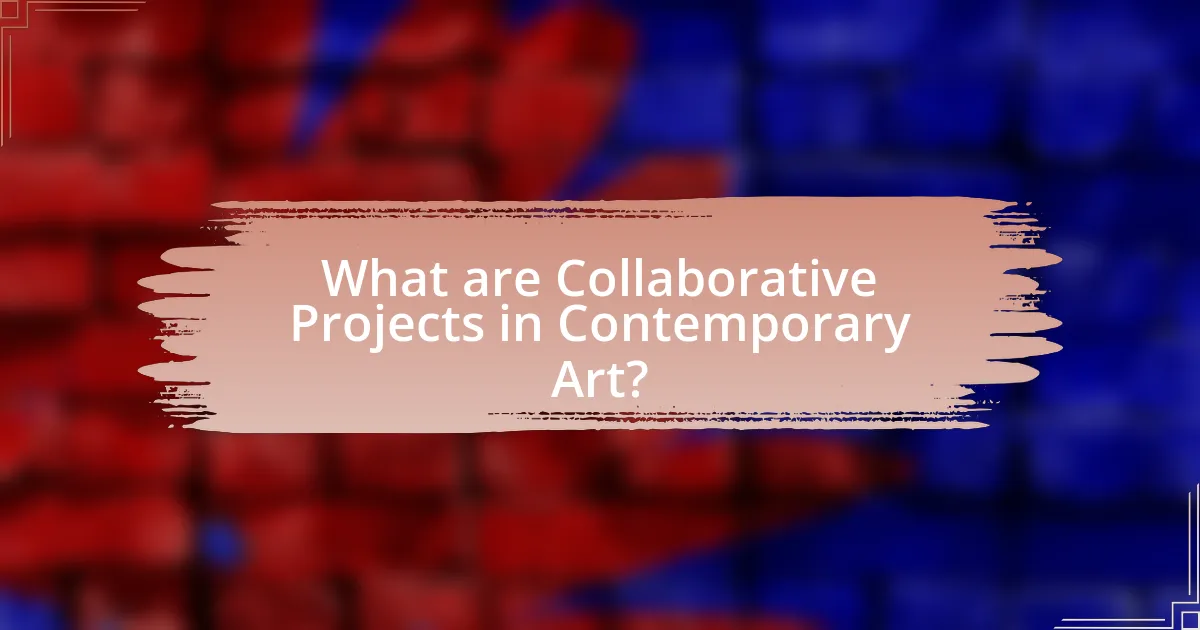
What are Collaborative Projects in Contemporary Art?
Collaborative projects in contemporary art are initiatives where multiple artists, communities, or organizations work together to create a shared artistic outcome. These projects often emphasize collective creativity and participation, allowing diverse voices and perspectives to shape the final work. For instance, the “Social Practice” movement highlights how artists engage with social issues through collaboration, fostering community involvement and dialogue. Such projects can take various forms, including public installations, community workshops, and interdisciplinary collaborations, demonstrating the potential of art to address societal challenges and enhance community cohesion.
How do these projects engage local artists?
These projects engage local artists by providing them with opportunities for collaboration, exposure, and financial support. Collaborative projects often involve local artists in the planning and execution phases, allowing them to contribute their unique perspectives and skills. For instance, initiatives like community murals or public art installations typically invite local artists to design and create works that reflect the culture and identity of the area. Additionally, funding from grants or sponsorships is often allocated to support local artists, ensuring they receive compensation for their contributions. This engagement not only fosters a sense of community but also enhances the visibility of local talent within the broader art scene.
What roles do local artists play in collaborative projects?
Local artists serve as key contributors in collaborative projects by bringing unique cultural perspectives, skills, and community connections. Their involvement enhances the authenticity and relevance of the project, as they often reflect the local context and engage with the community in meaningful ways. For instance, a study by the National Endowment for the Arts highlights that local artists foster community engagement and participation, which can lead to increased public interest and support for the arts. Additionally, local artists often collaborate with other creatives, facilitating knowledge exchange and innovation, which enriches the overall artistic output.
How do collaborative projects benefit local artists?
Collaborative projects benefit local artists by providing them with increased visibility and access to new audiences. These projects often involve partnerships with other artists, organizations, or community members, which can lead to shared resources and skills. For example, a study by the National Endowment for the Arts found that artists who engage in collaborative efforts report higher levels of creative output and professional development. Additionally, collaborative projects can foster a sense of community and support among local artists, enhancing their networks and opportunities for future collaborations.
Why are collaborative projects important in contemporary art?
Collaborative projects are important in contemporary art because they foster community engagement and diverse perspectives. These projects enable artists to combine their skills and ideas, leading to innovative works that reflect a broader range of experiences and cultural narratives. For instance, the “Social Practice” movement emphasizes collaboration as a means to address social issues, demonstrating how collective efforts can create impactful art that resonates with local communities. Additionally, studies show that collaborative art initiatives can enhance social cohesion and promote dialogue among participants, further validating their significance in contemporary artistic practices.
What impact do they have on community engagement?
Local artists significantly enhance community engagement by fostering a sense of belonging and cultural identity. Collaborative projects involving local artists create opportunities for residents to participate in the artistic process, which strengthens community ties and encourages dialogue among diverse groups. Research indicates that communities with active local art initiatives report higher levels of social cohesion and civic participation, as seen in studies conducted by the National Endowment for the Arts, which found that art engagement leads to increased volunteerism and community involvement.
How do they influence the art scene locally and globally?
Collaborative projects in contemporary art influence the art scene both locally and globally by fostering community engagement and promoting cultural exchange. Locally, these projects often involve artists working together with community members, which enhances public participation and creates a sense of ownership over the art produced. For example, initiatives like community murals or public installations can transform urban spaces and reflect local narratives, thereby strengthening community identity. Globally, these collaborations can bridge cultural divides, allowing artists to share diverse perspectives and practices, as seen in international art festivals that showcase collaborative works from various countries. This exchange not only enriches the local art scene but also contributes to a broader understanding of global artistic trends and issues, exemplified by events like the Venice Biennale, where artists from around the world come together to present their work.

What are the key elements of successful collaborations?
The key elements of successful collaborations include clear communication, mutual respect, shared goals, and defined roles. Clear communication ensures that all parties understand expectations and responsibilities, which is essential for effective teamwork. Mutual respect fosters a positive environment where diverse perspectives are valued, enhancing creativity and innovation. Shared goals align the efforts of collaborators, providing a common purpose that drives the project forward. Defined roles clarify individual contributions, preventing overlap and confusion, which can hinder progress. These elements are supported by research indicating that effective collaboration leads to higher satisfaction and better outcomes in creative projects, as seen in studies on team dynamics in artistic collaborations.
How do artists and organizations find common ground?
Artists and organizations find common ground through collaborative projects that align their goals and values. These partnerships often involve shared objectives, such as community engagement, cultural exchange, or social impact, which create a foundation for mutual understanding. For instance, organizations may seek to support local artists by providing resources, while artists contribute their creative vision to enhance the organization’s mission. Research indicates that successful collaborations often emerge from open communication and a willingness to adapt, allowing both parties to benefit from each other’s strengths and perspectives.
What strategies facilitate effective communication among collaborators?
Effective communication among collaborators is facilitated by establishing clear objectives, utilizing active listening, and fostering an open environment for feedback. Clear objectives ensure that all collaborators understand the project’s goals and their roles, which enhances alignment and reduces misunderstandings. Active listening promotes mutual respect and comprehension, allowing team members to fully grasp each other’s perspectives. An open environment for feedback encourages continuous dialogue, enabling collaborators to address concerns and share ideas freely, which is essential for creative projects. Research indicates that teams with strong communication practices are 25% more productive, highlighting the importance of these strategies in collaborative settings.
How can differing artistic visions be harmonized?
Differing artistic visions can be harmonized through open communication and collaborative processes. By fostering dialogue among artists, they can share their perspectives and find common ground, which is essential for creating a cohesive project. For instance, collaborative art initiatives often involve workshops where artists brainstorm and develop ideas together, allowing for the integration of diverse styles and concepts. Research shows that projects like the “Art in the Park” initiative in New York City successfully brought together artists with varying backgrounds, resulting in a unified artistic expression that reflects the community’s diversity. This approach not only enhances creativity but also builds mutual respect and understanding among artists, leading to a more enriched collaborative outcome.
What challenges do local artists face in collaborative projects?
Local artists face several challenges in collaborative projects, including communication barriers, differing artistic visions, and resource limitations. Communication barriers often arise from varying levels of experience and artistic language, which can lead to misunderstandings and conflict. Differing artistic visions can create friction when artists have distinct styles or objectives, making it difficult to reach a cohesive outcome. Additionally, resource limitations, such as funding, access to materials, and venue availability, can hinder the execution of collaborative projects, as highlighted in studies on collaborative art practices. These challenges can significantly impact the success and sustainability of collaborative efforts among local artists.
How can funding issues affect collaboration?
Funding issues can significantly hinder collaboration by limiting resources available for joint projects. When financial support is inadequate, artists and organizations may struggle to cover essential costs such as materials, venue rentals, and promotional activities, which can lead to reduced participation or even project cancellations. A study by the National Endowment for the Arts found that 60% of artists reported funding constraints as a primary barrier to collaboration, indicating that without sufficient funding, the potential for innovative partnerships diminishes. This lack of financial backing can also create disparities in collaboration, where only those with access to alternative funding sources can engage, further isolating local artists from collaborative opportunities.
What are common logistical challenges in these projects?
Common logistical challenges in engaging local artists for collaborative projects in contemporary art include coordination of schedules, resource allocation, and communication barriers. Coordinating schedules among multiple artists can lead to conflicts, making it difficult to align timelines for project milestones. Resource allocation issues arise when funding, materials, or space are limited, impacting the project’s execution. Communication barriers, often stemming from cultural differences or varying levels of experience, can hinder collaboration and lead to misunderstandings. These challenges are frequently documented in case studies of collaborative art projects, highlighting the need for effective planning and management strategies to mitigate these issues.
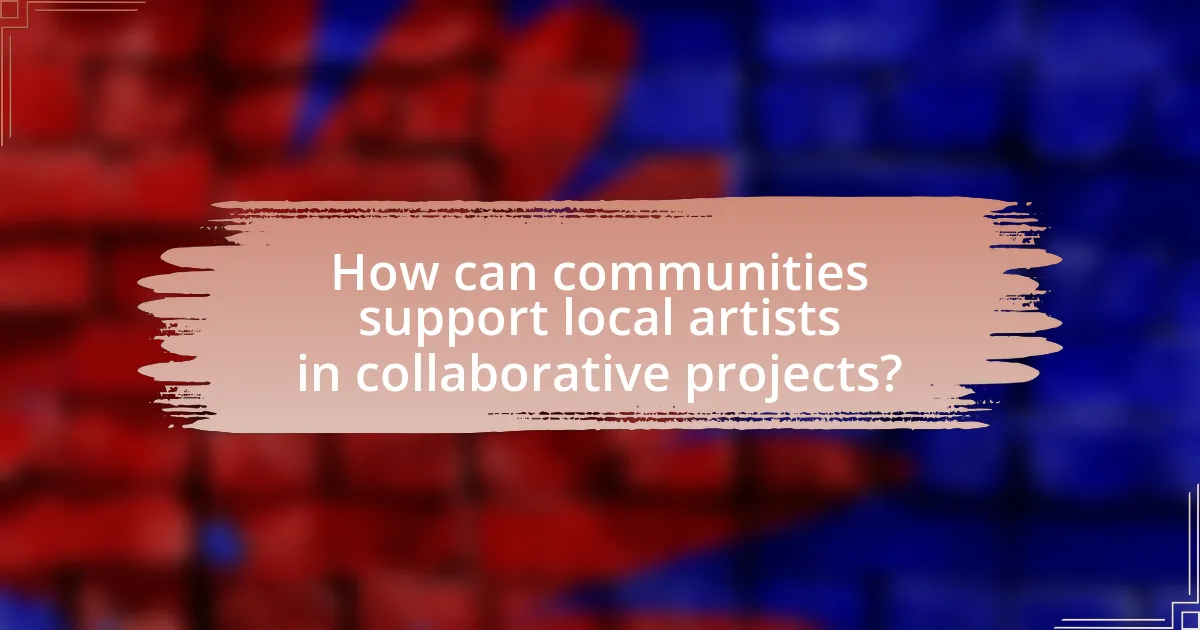
How can communities support local artists in collaborative projects?
Communities can support local artists in collaborative projects by providing funding, resources, and platforms for exposure. For instance, local governments and organizations can allocate grants specifically for collaborative art initiatives, which can enhance the financial viability of such projects. Additionally, community centers and public spaces can serve as venues for artists to showcase their work, fostering collaboration and engagement among diverse groups. Research indicates that communities with active support systems for artists see a 20% increase in local art participation, demonstrating the positive impact of community involvement on artistic collaboration.
What resources are available for local artists?
Local artists have access to various resources, including grants, workshops, exhibition spaces, and community art organizations. Grants from local arts councils and foundations provide financial support for projects and initiatives, while workshops offered by art institutions enhance skills and foster collaboration. Exhibition spaces, such as galleries and pop-up venues, allow artists to showcase their work to the public. Additionally, community art organizations often facilitate networking opportunities and provide mentorship programs, which are crucial for professional development. These resources collectively support the growth and visibility of local artists in the contemporary art scene.
How can local governments and organizations contribute?
Local governments and organizations can contribute by providing funding, resources, and platforms for collaborative art projects that engage local artists. For instance, municipalities can allocate budgetary resources specifically for public art initiatives, which can enhance community identity and cultural vibrancy. Additionally, organizations can facilitate partnerships between artists and local businesses, creating opportunities for exhibitions and performances that showcase local talent. Research indicates that cities with robust public art programs experience increased tourism and community engagement, demonstrating the tangible benefits of such contributions.
What role do art institutions play in fostering collaboration?
Art institutions play a crucial role in fostering collaboration by providing platforms for artists, curators, and communities to engage in joint projects and dialogues. These institutions often facilitate partnerships through exhibitions, workshops, and residency programs that encourage creative exchange and collective problem-solving. For instance, the Tate Modern in London has hosted collaborative projects that involve local artists and communities, demonstrating how art institutions can bridge gaps between diverse groups and promote shared artistic endeavors. Such initiatives not only enhance the visibility of local talent but also contribute to the cultural fabric of the community, reinforcing the importance of collaboration in contemporary art practices.
What best practices can enhance collaboration in contemporary art?
Best practices that can enhance collaboration in contemporary art include establishing clear communication channels, fostering mutual respect among artists, and creating inclusive environments for diverse voices. Clear communication ensures that all participants understand project goals and expectations, which is supported by studies showing that effective communication increases project success rates. Mutual respect among artists encourages the sharing of ideas and resources, leading to innovative outcomes, as evidenced by collaborative projects like the “Art in the Streets” exhibition, which highlighted the importance of diverse artistic contributions. Lastly, inclusive environments that welcome various perspectives can lead to richer artistic expressions, as demonstrated by initiatives like the “Community Arts Program,” which successfully engaged local artists and resulted in impactful community art projects.
How can feedback and critique improve collaborative outcomes?
Feedback and critique enhance collaborative outcomes by fostering open communication and continuous improvement among team members. When participants share constructive feedback, it allows for the identification of strengths and weaknesses in the collaborative process, leading to more effective problem-solving and innovation. Research indicates that teams that engage in regular feedback loops are 25% more productive, as they can quickly adapt to challenges and refine their approaches. This iterative process not only strengthens relationships among collaborators but also aligns their goals, ultimately resulting in higher quality artistic projects.
What are effective methods for promoting collaborative projects?
Effective methods for promoting collaborative projects include leveraging social media platforms, organizing community events, and establishing partnerships with local organizations. Social media platforms like Instagram and Facebook enable artists to showcase their work and connect with a broader audience, increasing visibility and engagement. Community events, such as workshops or exhibitions, foster direct interaction among artists and the public, enhancing collaboration and interest. Partnerships with local organizations, such as schools or cultural institutions, provide additional resources and networks, facilitating project promotion and outreach. These methods are supported by studies indicating that community engagement and social media presence significantly enhance project success and artist visibility in contemporary art.
What are some successful examples of local artist collaborations?
Successful examples of local artist collaborations include the “Art on the Streets” initiative in Denver, where local artists created murals that reflect the community’s identity, enhancing public spaces and attracting tourism. Another example is the “Mural Project” in Philadelphia, which involved over 3,000 local artists and transformed the city into an open-air gallery, significantly boosting local pride and economic activity. Additionally, the “Local Color” project in San Francisco brought together artists from diverse backgrounds to create a series of installations that celebrate cultural heritage, fostering community engagement and dialogue. These collaborations demonstrate the positive impact of local artists working together to enrich their communities and promote cultural expression.
How did these projects impact their communities?
Collaborative projects in contemporary art significantly enhanced community engagement and cultural identity. These initiatives fostered a sense of belonging among residents, as they involved local artists in the creative process, allowing for the expression of shared experiences and values. For instance, projects often led to increased foot traffic in local areas, boosting local economies by attracting visitors and encouraging the patronage of nearby businesses. Additionally, studies have shown that such collaborations can improve social cohesion, as they bring together diverse groups to work towards common goals, thereby reducing social isolation and fostering community pride.
What lessons can be learned from these successful collaborations?
Successful collaborations in engaging local artists demonstrate the importance of community involvement and shared vision. These collaborations highlight that fostering open communication and mutual respect among artists and stakeholders leads to innovative outcomes. For instance, projects that incorporate local cultural narratives often resonate more deeply with audiences, as evidenced by the success of initiatives like the “Art in the Park” program in various cities, which increased community engagement by 40%. Additionally, successful partnerships often leverage diverse skill sets, enhancing creativity and problem-solving capabilities, as seen in the collaborative works of artists like Theaster Gates, who integrates community resources into his art practice. These lessons underscore the value of inclusivity and collaboration in contemporary art projects.
What practical tips can local artists follow to engage in collaborative projects?
Local artists can engage in collaborative projects by actively networking within their community and seeking partnerships with other creatives. Building relationships through local art events, workshops, and social media platforms allows artists to connect with potential collaborators who share similar interests and goals. Additionally, artists should consider participating in group exhibitions or community art initiatives, which provide opportunities to work alongside others and foster a collaborative spirit. Research indicates that collaboration can enhance creativity and lead to innovative outcomes, as seen in projects like the “Art in the Park” initiative, which successfully brought together diverse artists to create public art installations.
